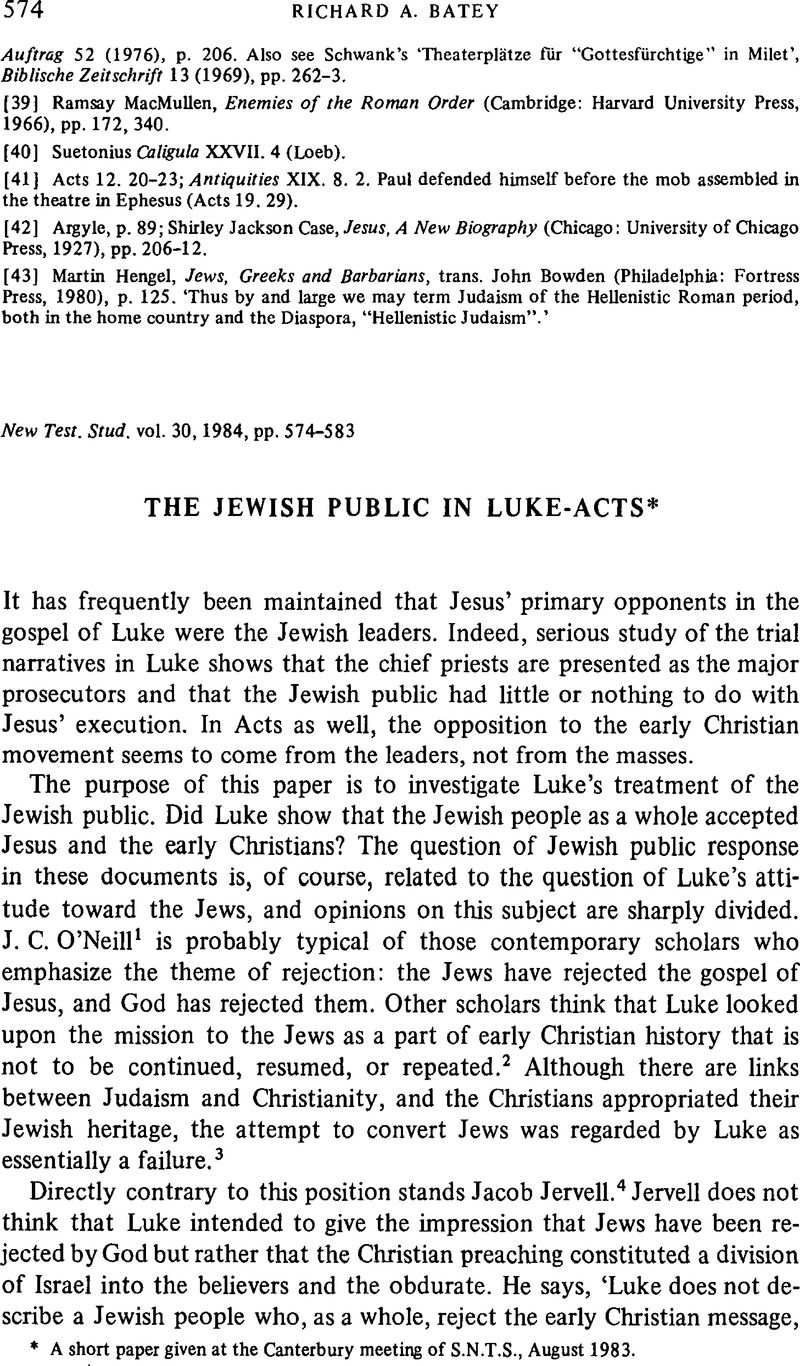Published online by Cambridge University Press: 05 February 2009

[1] The Theology of Acts in its Historical Setting (London: SPCK, 1961).Google Scholar
[2] Cf. Conzelmann, Hans, The Theology of St. Luke, trans. by Geoffrey, Buswell (New York: Harper and Brothers, 1960), pp. 209–25.Google Scholar
[3] Cf., e.g. Haenchen, Ernst, The Acts of the Apostles, trans. by Bernard, Noble et al. (Oxford: Basil Blackwell, 1971), pp. 98–103.Google Scholar
[4] ‘The Divided People of God’, in Luke and the People of God (Minneapolis: Augsburg, 1972).Google Scholar This essay was first published in Studia Theologica 19 (1965).Google ScholarCf. also George, Augustin, ‘Israel dans l'oeuvre de Luc’, Revue Biblique 75 (1968), pp. 481–525, whose views are similar to Jervell's.Google Scholar
[5] Jervell, , op. cit., p. 42.Google Scholar
[6] Ibid., p. 55.
[7] Missoula: Scholars Press, 1974.
[8] ‘A People for His Name’, NTS 4 (1958), pp. 319–327.CrossRefGoogle Scholar
[9] Ibid., p. 324.
[10] Ibid.
[11] Ibid., p. 326.
[12] Plēthos sometimes is used to designate a Jewish group, but in several cases it also designates Christians, either Jewish or Greek (e.g. Acts 4. 32; 5. 14; 6. 2, 5; 14. 1; 15. 12, 30; 17. 4).Dēmos, used only in Acts in the NT, usually has a political connotation, i.e. citizens (cf. Acts 12. 22; 17. 5; 19. 30, 33). Of course, the plural Ioudaioi is frequently found. The plural, Israēlitae, is used only in combination with andres, as a form of address, in Acts 2. 22; 3. 12; 5. 35; 13. 16; 21. 28.
[13] In Luke 23. 27, 48, the crowd seems to confirm the cosmic importance of Jesus' death and to demonstrate the response that Luke wishes to evoke from the reader. But nowhere else in Luke-Acts does the crowd function as Chorus.
[14] Cf. Aristotle, , The Poetics, XIII, 6.Google Scholar
[15] Cf., e.g. the various essays in Eltester, W., ed., Jesus in Nazareth (Berlin: Walter de Gruyter, 1972).Google Scholar
[16] Cf. Matt. 13. 53–58; Mark 6.1–6.
[17] Cf. Tannehill, Robert C., ‘The Mission of Jesus According to Luke IV: 16–30’Google Scholar, in Eltester, W., op. cit., pp. 51–75.Google Scholar Tannehill says that verses 25–27 ‘were inserted here by Luke in order to suggest the connection between the rejection of Jesus and his turning to others which occurs at Nazareth and the rejection of the gospel by the Jews and turning of the missionaries to the Gentiles which Luke will trace in Acts’ (ibid., p. 59).
[18] In Luke 7. 13–32, Jesus expresses similar lines of opposition in the form of a simile: the anthrōpoi of this generation are like children who sit in the agora and refuse to respond to another group of children. They refuse to respond to the flute by dancing or to the sound of mourning by crying. The simile changes to more literal speech in 7. 33–34. Like the children who called out in mourning, John was ascetic, but it was said that he had a demon. Like the children who called out with the flute, Jesus was not ascetic, but he was charged with gluttony. The methods of the two were different, but the response by ‘the anthrōpoi of this generation’ was the same. In 7. 35, we have the response of wisdom's children: ‘Wisdom is justified by all her children.’ This saying, which may have been a popular maxim, seems at first glance not to suit the Lukan context. It does, however, connect with the simile in 7. 32 by use of the figure of children and with 7. 29, where publicans justify God. The children in 7. 35 justify wisdom as the publicans in 7. 29 justify God. Taken together, the verses, 7. 24–35, set up certain lines of opposition, with Jesus, John, the people who listen, publicans, and wisdom's children on one side. Opposed to them are Pharisees, lawyers, the anthrōpoi of this generation, and the children who refused to mourn or dance.
[19] In Luke 23. 18, 21, 23, the subject is an indefinite third person plural, but the grammatical reference would be to the chief priests and the people (laos) in 23.13.
[20] Perhaps Luke does not intend to imply that Jesus' popular support had totally evaporated. In Luke 23. 27, he reports that ‘there followed him a great multitude of the people and of women who bewailed and lamented him’. Moreover, in 23. 49, his acquaintances and some Galilean women stand away from the larger crowd at the crucifixion, and in 23. 55, the Galilean women inspect Jesus' tomb. There is a remnant of supporters. Despite the terminology, this group does not reflect the popular response to Jesus. The impression that is conveyed in these verses is that of a loyal but beleaguered group of Galileans, whose support of Jesus is totally ineffective when put up against the rejection of the crowd as a whole. This group is not part of the crowd. Even if Luke 23. 48 says that the crowds (ochloi) gave expression to the same symbol as did Jesus' acquaintances in 23. 27, i.e. beating the breast, we are not to confuse the two groups. For 23. 49 makes a clear distinction between them, since Luke says there that the acquaintances and the women distanced themselves from the crowds and watched them as they returned home.
[21] In Acts 21. 27 (cf. 24. 18), Luke says that the riot at the Temple was incited by Jews from Asia. But he does not consistently indicate that the actions of diaspora Jews were different from those of Palestinian Jews. For example, the plot against Paul that is described in Acts 23. 12–22 is probably to be understood as devised by Palestinian Jews.
[22] The speakers in Acts 22. 22 are indefinite, but the third person plural refers to the people who were being addressed, last mentioned in 21. 40.
[23] Cf. Haenchen, , op. cit., p. 724.Google Scholar